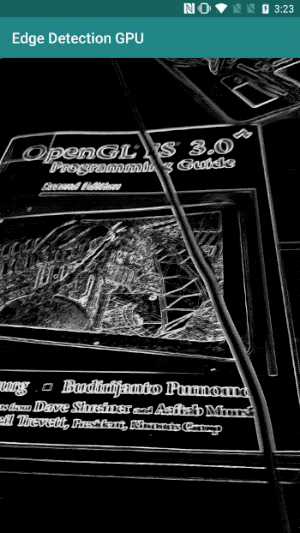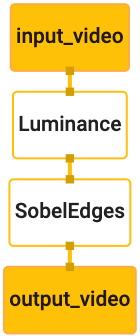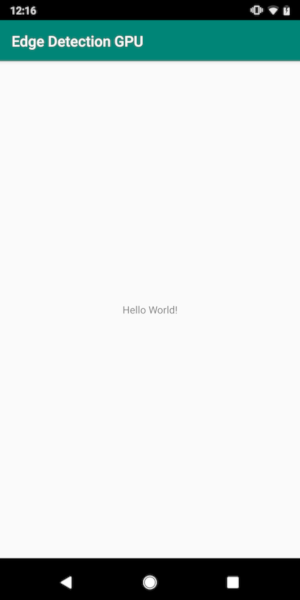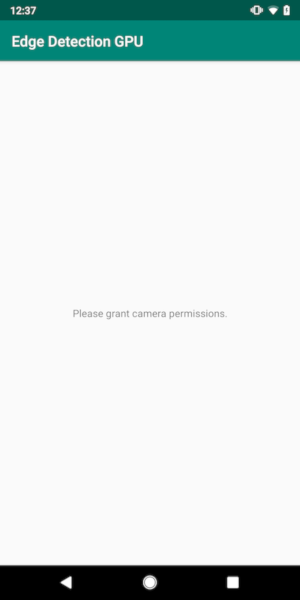---
layout: default
title: Hello World! on Android
parent: Getting Started
nav_order: 3
---
# Hello World! on Android
{: .no_toc }
1. TOC
{:toc}
---
## Introduction
This codelab uses MediaPipe on an Android device.
### What you will learn
How to develop an Android application that uses MediaPipe and run a MediaPipe
graph on Android.
### What you will build
A simple camera app for real-time Sobel edge detection applied to a live video
stream on an Android device.

## Setup
1. Install MediaPipe on your system, see [MediaPipe installation guide] for
details.
2. Install Android Development SDK and Android NDK. See how to do so also in
[MediaPipe installation guide].
3. Enable [developer options] on your Android device.
4. Setup [Bazel] on your system to build and deploy the Android app.
## Graph for edge detection
We will be using the following graph, [`edge_detection_mobile_gpu.pbtxt`]:
```
# MediaPipe graph that performs GPU Sobel edge detection on a live video stream.
# Used in the examples in
# mediapipe/examples/android/src/java/com/mediapipe/apps/basic and
# mediapipe/examples/ios/edgedetectiongpu.
# Images coming into and out of the graph.
input_stream: "input_video"
output_stream: "output_video"
# Converts RGB images into luminance images, still stored in RGB format.
node: {
calculator: "LuminanceCalculator"
input_stream: "input_video"
output_stream: "luma_video"
}
# Applies the Sobel filter to luminance images sotred in RGB format.
node: {
calculator: "SobelEdgesCalculator"
input_stream: "luma_video"
output_stream: "output_video"
}
```
A visualization of the graph is shown below:

This graph has a single input stream named `input_video` for all incoming frames
that will be provided by your device's camera.
The first node in the graph, `LuminanceCalculator`, takes a single packet (image
frame) and applies a change in luminance using an OpenGL shader. The resulting
image frame is sent to the `luma_video` output stream.
The second node, `SobelEdgesCalculator` applies edge detection to incoming
packets in the `luma_video` stream and outputs results in `output_video` output
stream.
Our Android application will display the output image frames of the
`output_video` stream.
## Initial minimal application setup
We first start with an simple Android application that displays "Hello World!"
on the screen. You may skip this step if you are familiar with building Android
applications using `bazel`.
Create a new directory where you will create your Android application. For
example, the complete code of this tutorial can be found at
`mediapipe/examples/android/src/java/com/google/mediapipe/apps/basic`. We
will refer to this path as `$APPLICATION_PATH` throughout the codelab.
Note that in the path to the application:
* The application is named `helloworld`.
* The `$PACKAGE_PATH` of the application is
`com.google.mediapipe.apps.basic`. This is used in code snippets in this
tutorial, so please remember to use your own `$PACKAGE_PATH` when you
copy/use the code snippets.
Add a file `activity_main.xml` to `$APPLICATION_PATH/res/layout`. This displays
a [`TextView`] on the full screen of the application with the string `Hello
World!`:
```
```
Add a simple `MainActivity.java` to `$APPLICATION_PATH` which loads the content
of the `activity_main.xml` layout as shown below:
```
package com.google.mediapipe.apps.basic;
import android.os.Bundle;
import androidx.appcompat.app.AppCompatActivity;
/** Bare-bones main activity. */
public class MainActivity extends AppCompatActivity {
@Override
protected void onCreate(Bundle savedInstanceState) {
super.onCreate(savedInstanceState);
setContentView(R.layout.activity_main);
}
}
```
Add a manifest file, `AndroidManifest.xml` to `$APPLICATION_PATH`, which
launches `MainActivity` on application start:
```
```
In our application we are using a `Theme.AppCompat` theme in the app, so we need
appropriate theme references. Add `colors.xml` to
`$APPLICATION_PATH/res/values/`:
```
#008577
#00574B
#D81B60
```
Add `styles.xml` to `$APPLICATION_PATH/res/values/`:
```
```
To build the application, add a `BUILD` file to `$APPLICATION_PATH`, and
`${appName}` and `${mainActivity}` in the manifest will be replaced by strings
specified in `BUILD` as shown below.
```
android_library(
name = "basic_lib",
srcs = glob(["*.java"]),
manifest = "AndroidManifest.xml",
resource_files = glob(["res/**"]),
deps = [
"//third_party:android_constraint_layout",
"//third_party:androidx_appcompat",
],
)
android_binary(
name = "helloworld",
manifest = "AndroidManifest.xml",
manifest_values = {
"applicationId": "com.google.mediapipe.apps.basic",
"appName": "Hello World",
"mainActivity": ".MainActivity",
},
multidex = "native",
deps = [
":basic_lib",
],
)
```
The `android_library` rule adds dependencies for `MainActivity`, resource files
and `AndroidManifest.xml`.
The `android_binary` rule, uses the `basic_lib` Android library generated to
build a binary APK for installation on your Android device.
To build the app, use the following command:
```
bazel build -c opt --config=android_arm64 $APPLICATION_PATH:helloworld
```
Install the generated APK file using `adb install`. For example:
```
adb install bazel-bin/$APPLICATION_PATH/helloworld.apk
```
Open the application on your device. It should display a screen with the text
`Hello World!`.

## Using the camera via `CameraX`
### Camera Permissions
To use the camera in our application, we need to request the user to provide
access to the camera. To request camera permissions, add the following to
`AndroidManifest.xml`:
```
```
Change the minimum SDK version to `21` and target SDK version to `27` in the
same file:
```
```
This ensures that the user is prompted to request camera permission and enables
us to use the [CameraX] library for camera access.
To request camera permissions, we can use a utility provided by MediaPipe
components, namely [`PermissionHelper`]. To use it, add a dependency
`"//mediapipe/java/com/google/mediapipe/components:android_components"` in the
`mediapipe_lib` rule in `BUILD`.
To use the `PermissionHelper` in `MainActivity`, add the following line to the
`onCreate` function:
```
PermissionHelper.checkAndRequestCameraPermissions(this);
```
This prompts the user with a dialog on the screen to request for permissions to
use the camera in this application.
Add the following code to handle the user response:
```
@Override
public void onRequestPermissionsResult(
int requestCode, String[] permissions, int[] grantResults) {
super.onRequestPermissionsResult(requestCode, permissions, grantResults);
PermissionHelper.onRequestPermissionsResult(requestCode, permissions, grantResults);
}
@Override
protected void onResume() {
super.onResume();
if (PermissionHelper.cameraPermissionsGranted(this)) {
startCamera();
}
}
public void startCamera() {}
```
We will leave the `startCamera()` method empty for now. When the user responds
to the prompt, the `MainActivity` will resume and `onResume()` will be called.
The code will confirm that permissions for using the camera have been granted,
and then will start the camera.
Rebuild and install the application. You should now see a prompt requesting
access to the camera for the application.
Note: If the there is no dialog prompt, uninstall and reinstall the application.
This may also happen if you haven't changed the `minSdkVersion` and
`targetSdkVersion` in the `AndroidManifest.xml` file.
### Camera Access
With camera permissions available, we can start and fetch frames from the
camera.
To view the frames from the camera we will use a [`SurfaceView`]. Each frame
from the camera will be stored in a [`SurfaceTexture`] object. To use these, we
first need to change the layout of our application.
Remove the entire [`TextView`] code block from
`$APPLICATION_PATH/res/layout/activity_main.xml` and add the following code
instead:
```
```
This code block has a new [`FrameLayout`] named `preview_display_layout` and a
[`TextView`] nested inside it, named `no_camera_access_preview`. When camera
access permissions are not granted, our application will display the
[`TextView`] with a string message, stored in the variable `no_camera_access`.
Add the following line in the `$APPLICATION_PATH/res/values/strings.xml` file:
```
Please grant camera permissions.
```
When the user doesn't grant camera permission, the screen will now look like
this:

Now, we will add the [`SurfaceTexture`] and [`SurfaceView`] objects to
`MainActivity`:
```
private SurfaceTexture previewFrameTexture;
private SurfaceView previewDisplayView;
```
In the `onCreate(Bundle)` function, add the following two lines _before_
requesting camera permissions:
```
previewDisplayView = new SurfaceView(this);
setupPreviewDisplayView();
```
And now add the code defining `setupPreviewDisplayView()`:
```
private void setupPreviewDisplayView() {
previewDisplayView.setVisibility(View.GONE);
ViewGroup viewGroup = findViewById(R.id.preview_display_layout);
viewGroup.addView(previewDisplayView);
}
```
We define a new [`SurfaceView`] object and add it to the
`preview_display_layout` [`FrameLayout`] object so that we can use it to display
the camera frames using a [`SurfaceTexture`] object named `previewFrameTexture`.
To use `previewFrameTexture` for getting camera frames, we will use [CameraX].
MediaPipe provides a utility named [`CameraXPreviewHelper`] to use [CameraX].
This class updates a listener when camera is started via
`onCameraStarted(@Nullable SurfaceTexture)`.
To use this utility, modify the `BUILD` file to add a dependency on
`"//mediapipe/java/com/google/mediapipe/components:android_camerax_helper"`.
Now import [`CameraXPreviewHelper`] and add the following line to
`MainActivity`:
```
private CameraXPreviewHelper cameraHelper;
```
Now, we can add our implementation to `startCamera()`:
```
public void startCamera() {
cameraHelper = new CameraXPreviewHelper();
cameraHelper.setOnCameraStartedListener(
surfaceTexture -> {
previewFrameTexture = surfaceTexture;
// Make the display view visible to start showing the preview.
previewDisplayView.setVisibility(View.VISIBLE);
});
}
```
This creates a new [`CameraXPreviewHelper`] object and adds an anonymous
listener on the object. When `cameraHelper` signals that the camera has started
and a `surfaceTexture` to grab frames is available, we save that
`surfaceTexture` as `previewFrameTexture`, and make the `previewDisplayView`
visible so that we can start seeing frames from the `previewFrameTexture`.
However, before starting the camera, we need to decide which camera we want to
use. [`CameraXPreviewHelper`] inherits from [`CameraHelper`] which provides two
options, `FRONT` and `BACK`. We can pass in the decision from the `BUILD` file
as metadata such that no code change is required to build another version of the
app using a different camera.
Assuming we want to use `BACK` camera to perform edge detection on a live scene
that we view from the camera, add the metadata into `AndroidManifest.xml`:
```
...
```
and specify the selection in `BUILD` in the `helloworld` android binary rule
with a new entry in `manifest_values`:
```
manifest_values = {
"applicationId": "com.google.mediapipe.apps.basic",
"appName": "Hello World",
"mainActivity": ".MainActivity",
"cameraFacingFront": "False",
},
```
Now, in `MainActivity` to retrieve the metadata specified in `manifest_values`,
add an [`ApplicationInfo`] object:
```
private ApplicationInfo applicationInfo;
```
In the `onCreate()` function, add:
```
try {
applicationInfo =
getPackageManager().getApplicationInfo(getPackageName(), PackageManager.GET_META_DATA);
} catch (NameNotFoundException e) {
Log.e(TAG, "Cannot find application info: " + e);
}
```
Now add the following line at the end of the `startCamera()` function:
```
CameraHelper.CameraFacing cameraFacing =
applicationInfo.metaData.getBoolean("cameraFacingFront", false)
? CameraHelper.CameraFacing.FRONT
: CameraHelper.CameraFacing.BACK;
cameraHelper.startCamera(this, cameraFacing, /*surfaceTexture=*/ null);
```
At this point, the application should build successfully. However, when you run
the application on your device, you will see a black screen (even though camera
permissions have been granted). This is because even though we save the
`surfaceTexture` variable provided by the [`CameraXPreviewHelper`], the
`previewSurfaceView` doesn't use its output and display it on screen yet.
Since we want to use the frames in a MediaPipe graph, we will not add code to
view the camera output directly in this tutorial. Instead, we skip ahead to how
we can send camera frames for processing to a MediaPipe graph and display the
output of the graph on the screen.
## `ExternalTextureConverter` setup
A [`SurfaceTexture`] captures image frames from a stream as an OpenGL ES
texture. To use a MediaPipe graph, frames captured from the camera should be
stored in a regular Open GL texture object. MediaPipe provides a class,
[`ExternalTextureConverter`] to convert the image stored in a [`SurfaceTexture`]
object to a regular OpenGL texture object.
To use [`ExternalTextureConverter`], we also need an `EGLContext`, which is
created and managed by an [`EglManager`] object. Add a dependency to the `BUILD`
file to use [`EglManager`], `"//mediapipe/java/com/google/mediapipe/glutil"`.
In `MainActivity`, add the following declarations:
```
private EglManager eglManager;
private ExternalTextureConverter converter;
```
In the `onCreate(Bundle)` function, add a statement to initialize the
`eglManager` object before requesting camera permissions:
```
eglManager = new EglManager(null);
```
Recall that we defined the `onResume()` function in `MainActivity` to confirm
camera permissions have been granted and call `startCamera()`. Before this
check, add the following line in `onResume()` to initialize the `converter`
object:
```
converter = new ExternalTextureConverter(eglManager.getContext());
```
This `converter` now uses the `GLContext` managed by `eglManager`.
We also need to override the `onPause()` function in the `MainActivity` so that
if the application goes into a paused state, we close the `converter` properly:
```
@Override
protected void onPause() {
super.onPause();
converter.close();
}
```
To pipe the output of `previewFrameTexture` to the `converter`, add the
following block of code to `setupPreviewDisplayView()`:
```
previewDisplayView
.getHolder()
.addCallback(
new SurfaceHolder.Callback() {
@Override
public void surfaceCreated(SurfaceHolder holder) {}
@Override
public void surfaceChanged(SurfaceHolder holder, int format, int width, int height) {
// (Re-)Compute the ideal size of the camera-preview display (the area that the
// camera-preview frames get rendered onto, potentially with scaling and rotation)
// based on the size of the SurfaceView that contains the display.
Size viewSize = new Size(width, height);
Size displaySize = cameraHelper.computeDisplaySizeFromViewSize(viewSize);
// Connect the converter to the camera-preview frames as its input (via
// previewFrameTexture), and configure the output width and height as the computed
// display size.
converter.setSurfaceTextureAndAttachToGLContext(
previewFrameTexture, displaySize.getWidth(), displaySize.getHeight());
}
@Override
public void surfaceDestroyed(SurfaceHolder holder) {}
});
```
In this code block, we add a custom [`SurfaceHolder.Callback`] to
`previewDisplayView` and implement the `surfaceChanged(SurfaceHolder holder, int
format, int width, int height)` function to compute an appropriate display size
of the camera frames on the device screen and to tie the `previewFrameTexture`
object and send frames of the computed `displaySize` to the `converter`.
We are now ready to use camera frames in a MediaPipe graph.
## Using a MediaPipe graph in Android
### Add relevant dependencies
To use a MediaPipe graph, we need to add dependencies to the MediaPipe framework
on Android. We will first add a build rule to build a `cc_binary` using JNI code
of the MediaPipe framework and then build a `cc_library` rule to use this binary
in our application. Add the following code block to your `BUILD` file:
```
cc_binary(
name = "libmediapipe_jni.so",
linkshared = 1,
linkstatic = 1,
deps = [
"//mediapipe/java/com/google/mediapipe/framework/jni:mediapipe_framework_jni",
],
)
cc_library(
name = "mediapipe_jni_lib",
srcs = [":libmediapipe_jni.so"],
alwayslink = 1,
)
```
Add the dependency `":mediapipe_jni_lib"` to the `mediapipe_lib` build rule in
the `BUILD` file.
Next, we need to add dependencies specific to the MediaPipe graph we want to use
in the application.
First, add dependencies to all calculator code in the `libmediapipe_jni.so`
build rule:
```
"//mediapipe/graphs/edge_detection:mobile_calculators",
```
MediaPipe graphs are `.pbtxt` files, but to use them in the application, we need
to use the `mediapipe_binary_graph` build rule to generate a `.binarypb` file.
In the `helloworld` android binary build rule, add the `mediapipe_binary_graph`
target specific to the graph as an asset:
```
assets = [
"//mediapipe/graphs/edge_detection:mobile_gpu_binary_graph",
],
assets_dir = "",
```
In the `assets` build rule, you can also add other assets such as TensorFlowLite
models used in your graph.
In addition, add additional `manifest_values` for properties specific to the
graph, to be later retrieved in `MainActivity`:
```
manifest_values = {
"applicationId": "com.google.mediapipe.apps.basic",
"appName": "Hello World",
"mainActivity": ".MainActivity",
"cameraFacingFront": "False",
"binaryGraphName": "mobile_gpu.binarypb",
"inputVideoStreamName": "input_video",
"outputVideoStreamName": "output_video",
},
```
Note that `binaryGraphName` indicates the filename of the binary graph,
determined by the `output_name` field in the `mediapipe_binary_graph` target.
`inputVideoStreamName` and `outputVideoStreamName` are the input and output
video stream name specified in the graph respectively.
Now, the `MainActivity` needs to load the MediaPipe framework. Also, the
framework uses OpenCV, so `MainActvity` should also load `OpenCV`. Use the
following code in `MainActivity` (inside the class, but not inside any function)
to load both dependencies:
```
static {
// Load all native libraries needed by the app.
System.loadLibrary("mediapipe_jni");
System.loadLibrary("opencv_java3");
}
```
### Use the graph in `MainActivity`
First, we need to load the asset which contains the `.binarypb` compiled from
the `.pbtxt` file of the graph. To do this, we can use a MediaPipe utility,
[`AndroidAssetUtil`].
Initialize the asset manager in `onCreate(Bundle)` before initializing
`eglManager`:
```
// Initialize asset manager so that MediaPipe native libraries can access the app assets, e.g.,
// binary graphs.
AndroidAssetUtil.initializeNativeAssetManager(this);
```
Now, we need to setup a [`FrameProcessor`] object that sends camera frames
prepared by the `converter` to the MediaPipe graph and runs the graph, prepares
the output and then updates the `previewDisplayView` to display the output. Add
the following code to declare the `FrameProcessor`:
```
private FrameProcessor processor;
```
and initialize it in `onCreate(Bundle)` after initializing `eglManager`:
```
processor =
new FrameProcessor(
this,
eglManager.getNativeContext(),
applicationInfo.metaData.getString("binaryGraphName"),
applicationInfo.metaData.getString("inputVideoStreamName"),
applicationInfo.metaData.getString("outputVideoStreamName"));
```
The `processor` needs to consume the converted frames from the `converter` for
processing. Add the following line to `onResume()` after initializing the
`converter`:
```
converter.setConsumer(processor);
```
The `processor` should send its output to `previewDisplayView` To do this, add
the following function definitions to our custom [`SurfaceHolder.Callback`]:
```
@Override
public void surfaceCreated(SurfaceHolder holder) {
processor.getVideoSurfaceOutput().setSurface(holder.getSurface());
}
@Override
public void surfaceDestroyed(SurfaceHolder holder) {
processor.getVideoSurfaceOutput().setSurface(null);
}
```
When the `SurfaceHolder` is created, we had the `Surface` to the
`VideoSurfaceOutput` of the `processor`. When it is destroyed, we remove it from
the `VideoSurfaceOutput` of the `processor`.
And that's it! You should now be able to successfully build and run the
application on the device and see Sobel edge detection running on a live camera
feed! Congrats!

If you ran into any issues, please see the full code of the tutorial
[here](https://github.com/google/mediapipe/tree/master/mediapipe/examples/android/src/java/com/google/mediapipe/apps/basic).
[`ApplicationInfo`]:https://developer.android.com/reference/android/content/pm/ApplicationInfo
[`AndroidAssetUtil`]:https://github.com/google/mediapipe/tree/master/mediapipe/java/com/google/mediapipe/framework/AndroidAssetUtil.java
[Bazel]:https://bazel.build/
[`CameraHelper`]:https://github.com/google/mediapipe/tree/master/mediapipe/java/com/google/mediapipe/components/CameraHelper.java
[CameraX]:https://developer.android.com/training/camerax
[`CameraXPreviewHelper`]:https://github.com/google/mediapipe/tree/master/mediapipe/java/com/google/mediapipe/components/CameraXPreviewHelper.java
[developer options]:https://developer.android.com/studio/debug/dev-options
[`edge_detection_mobile_gpu.pbtxt`]:https://github.com/google/mediapipe/tree/master/mediapipe/graphs/edge_detection/edge_detection_mobile_gpu.pbtxt
[`EglManager`]:https://github.com/google/mediapipe/tree/master/mediapipe/java/com/google/mediapipe/glutil/EglManager.java
[`ExternalTextureConverter`]:https://github.com/google/mediapipe/tree/master/mediapipe/java/com/google/mediapipe/components/ExternalTextureConverter.java
[`FrameLayout`]:https://developer.android.com/reference/android/widget/FrameLayout
[`FrameProcessor`]:https://github.com/google/mediapipe/tree/master/mediapipe/java/com/google/mediapipe/components/FrameProcessor.java
[MediaPipe installation guide]:./install.md
[`PermissionHelper`]: https://github.com/google/mediapipe/tree/master/mediapipe/java/com/google/mediapipe/components/PermissionHelper.java
[`SurfaceHolder.Callback`]:https://developer.android.com/reference/android/view/SurfaceHolder.Callback.html
[`SurfaceView`]:https://developer.android.com/reference/android/view/SurfaceView
[`SurfaceView`]:https://developer.android.com/reference/android/view/SurfaceView
[`SurfaceTexture`]:https://developer.android.com/reference/android/graphics/SurfaceTexture
[`TextView`]:https://developer.android.com/reference/android/widget/TextView